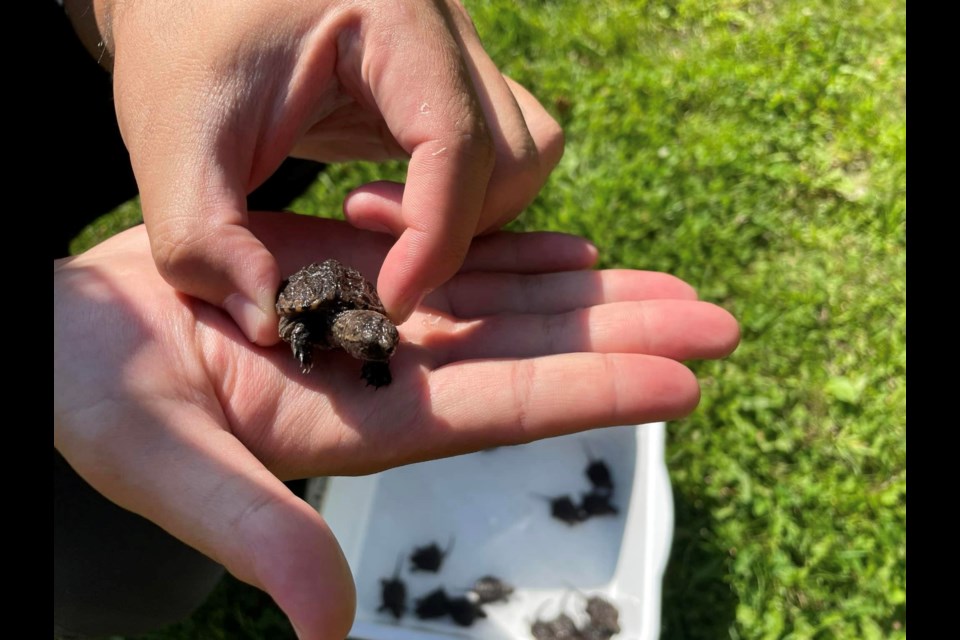ERIN/HILLSBURGH ‒ As construction for the future Elora-Cataract Trail sewer line is set to begin, one concerned resident is asking the Credit Valley Conservation Authority and the Ministry of Environment, Conservation, and Parks to provide additional mitigation measures to protect threatened species like the Blandings turtle nesting in and around the area.
This comes on the heels of Dig Erin's announcement that the Elora-Cataract Trail sewer construction will begin with six to eight weeks of tree and vegetation removal beginning Sept. 11, with the trail closing to the public on Sept. 5.
“Blandings are the sweetheart of the turtles and they’re also considered to be the highest at risk,” said Leah-Anne Goyeau, one of 155 members of the Erin-Hillsburgh Turtle Guardians. “(But) we’re now at a point where they’re there, they’ve nested and in the next couple weeks, at the same time they’re starting cutting and bulldozing the trail, they’re going to be in hatching season.”
During an informal information session at the Hillsburgh Arena Wednesday evening, when asked about mitigation measures, acting Erin CAO Jim Sawkins said that they wouldn't have been able to get construction approval from the CVC if they were causing damage to a species at risk.
Balancing her job as a full-time teacher with monitoring the two mill ponds in Hillsburgh, Goyeau currently wakes up early every morning to search for and mark the locations of nesting turtles before returning in the evening with a nesting box. She currently has approximately 20 nesting boxes throughout the area.
However, during construction, the stretch of trail that allows Goyeau access will be closed and she is concerned workers and the town alike will forget to watch out for the little guy.
“How is a turtle hatchling, the size of a toonie, gonna get its way out of the ground and where it needs to go,” said Goyeau. “It’s not going to be able to fight a thousand-pound tree if it drops on its nest.”
When a turtle nests, they often look for gravel substrates to lay their eggs in clutches; digging a hole, depositing their precious cargo, then covering everything back up. Lasting anywhere from 60 to 90 days, turtle hatching season starts directly after Labour Day weekend, running through until October.
But with thousands of trees to be felled and construction set to start Sept 11., Goyeau says it will create a perfect storm that could cause permanent damage to turtle populations in the area.
“Usually, when a turtle hatches, they need to get to water within 24 hours after hatching or they’ll dehydrate,” said Goyeau. “So the way I’m visualizing it, they’re just going to be walking through a bunch of trees lying all over the place.”
When asked what current and future protection efforts are being undertaken in regard to the nesting habitats and turtle populations in and around the construction site, the CVC said in an email statement that as project proponents, the town is responsible for minimizing the impact of the works on wildlife and has committed to implementing best practices through project implementation.
They also clarified that the town would also be required to follow any direction provided by the Ministry of Environment, Conservation and Parks under sections 9 and/or 10 of the Endangered Species Act should any species be present.
But with five nesting boxes alone between Station Road and Trafalgar, even if there is minimal impact this time around, Goyeau is concerned about the long-term impacts on turtle habitats during construction over the next two years causing gaps in turtle nesting.
“I love where I live and they’re killing what I love,” said Goyeau. “To me, it feels like we’re not thinking about preserving the beautiful, pristine ecology we have and essentially, we’re allowing the developers to run the show.”
Isabel Buckmaster is the Local Journalism Initiative reporter for GuelphToday. LJI is a federally-funded program.
